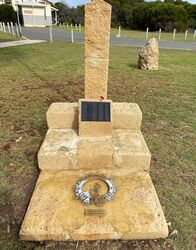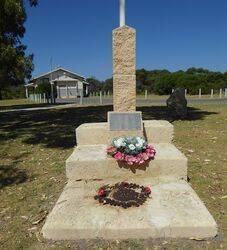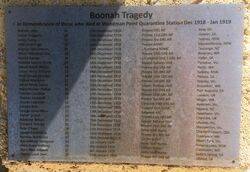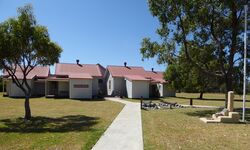
"Boonah" TragedyPrint Page 
The monument commemorates those from the troopship Boonah and nurses who died at the Woodman Point Quarantine Station between December 1918 and January 1919. It was dedicated on the 100th anniversary of the Boonah Tragedy on the 16th December 2018.
His Majesty's Australian Troopship Boonah, A36, sailed from Port Adelaide on 22nd October, 1918, bound for England via Fremantle and South Africa. She was the last Australian troop ship to leave Australia in World War One. Embarkation records indicate 760 troops boarded at Adelaide and a further 158 boarded when the ship left Fremantle on 29th October 1918. This included approximately 30 members of the Australian Army Medical Corps.
The Boonah arrived in Durban, South Africa on 14th November 1918, just three days after the armistice was signed, and on hearing the news, arrangements were made to promptly return home. Before her departure however, local stevedores from the Spanish 'flu stricken city were used to load and unload supplies from the ship and in the course of doing so infected soldiers who were billeted in crowded conditions throughout the ship.
The Boonah experienced harsh weather conditions on the return voyage to Australia, cold temperatures, icy decks, and rough seas confining soldiers below decks for considerable time in crowded conditions creating growing numbers of influenza symptoms.
By the time the Boonah had arrived back at Fremantle on the 12th of December 1918, more than 300 cases had been reported. Commonwealth immigration authorities initially refused to allow the soldiers to disembark, knowing of the global pandemic which was under way, but which had until then spared Western Australia.
After some delay approval was granted for the most unwell soldiers to be brought ashore to the Quarantine Station at Woodman Point. Using the tug "Alliance", it took 3 days for 337 men to be brought ashore with strong south westerly winds causing delays. Five men died on the first day at the station. The condition of some deteriorated further with more dying as well.
On board the "Boonah" where most of the men remained, conditions were said to be deplorable. A seven day incubation period with no new cases was required to prove that the disease had burnt itself out, but new infections and deaths continued, caused by the cramped and close living conditions.
Public outrage grew against the refusal of the immigration authorities to allow all of the soldiers ashore. Wrangling between the State Minister for Health, Sir Hal Colebatch, and the Federal immigration authorities continued, and tensions increased to the point that the Returned Servicemen's Association made threats to storm the ship to return the sick men to shore. After nine days of acrimony, and despite breaking quarantine regulations, the ship was ordered to depart, presumably to defuse the situation.
Another 17 cases were discovered between Albany and Adelaide, and the remaining men were disembarked at Torrens Island Quarantine Station. No further deaths occurred, and after being given the all-clear, the remaining men returned to their homes.
A total of 27 soldiers and 4 nurses at the Woodman Point Quarantine Station died of influenza during the crisis.
Location
| Address: | O`Kane Court, Woodman Point Recreation Camp, Coogee, 6166 |
|---|---|
| State: | WA |
| Area: | AUS |
| GPS Coordinates: | Lat: -32.133468 Long: 115.757528 Note: GPS Coordinates are approximate. |
Details
| Monument Type: | Monument |
|---|---|
| Monument Theme: | Disaster |
| Sub-Theme: | Pandemic |
| Approx. Event Start Date: | December-1918 |
| Approx. Event End Date: | January-1919 |
Dedication
| Actual Monument Dedication Date: | Sunday 16th December, 2018 |
|---|
Boonah Tragedy
In remembrance of those who died at Woodman Point Quarantine Station Dec 1918 - Jan 1919
[ Names ]
Lest We Forget
Plaque :
Together we remember
Donated by IFM Group & Cadmine Engineering to Friends of Woodman Point Quarantine Camp







